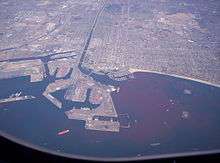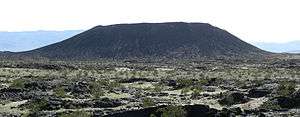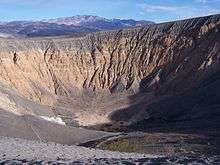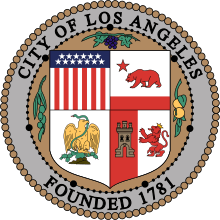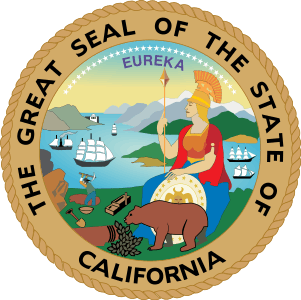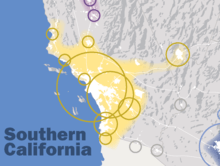Los Angeles metropolitan area
The Los Angeles metropolitan area, also known as Metropolitan Los Angeles, Metro LA or the Southland,[1] is the 18th largest metropolitan area in the world and the second-largest metropolitan area in the United States.[2] It is the 3rd largest city by nominal GDP in the world with a $1 trillion+ economy. It is entirely within Southern California.
Los Angeles Metropolitan Area | |
|---|---|
| Los Angeles–Long Beach–Anaheim MSA | |
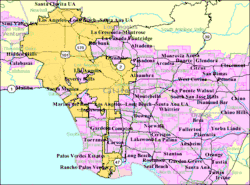 | |
| Coordinates: 33°54′N 118°15′W | |
| Country | United States |
| State(s) | |
| Largest city | |
| Other cities | Long Beach Anaheim Santa Ana Irvine Santa Clarita Glendale Huntington Beach Garden Grove Lancaster Palmdale Pomona Torrance Pasadena Orange Fullerton |
| Area | |
| • Total | 4,850.3 sq mi (12,562 km2) |
| Highest elevation | Mount San Antonio 10,068 ft (3,069 m) |
| Lowest elevation | Wilmington −9 ft (-3 m) |
| Population (2016) | |
| • Total | 13,310,447 |
| • Rank | 2nd in the U.S. |
| • Density | 2,744/sq mi (1,059/km2) |
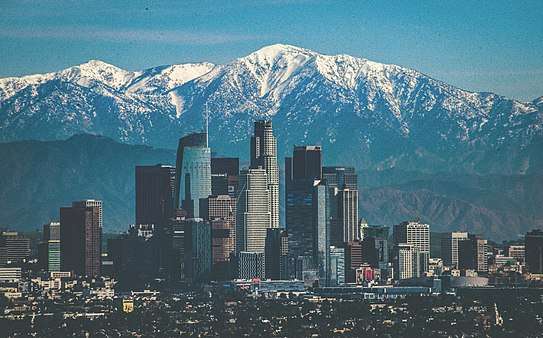

The metropolitan area is defined by the U.S. Office of Management and Budget as the Los Angeles-Long Beach-Anaheim, CA Metropolitan Statistical Area (MSA), consisting of Los Angeles and Orange counties, a metropolitan statistical area used for statistical purposes by the United States Census Bureau and other agencies.[3] Its land area is 4,850 sq. mi (12,562 km2) and its estimated 2016 population was 13,310,447 (a 3.75 percent increase over the official 2010 US Census population of 12,828,837).[4]
Los Angeles and Orange counties are the first- and third-most populous counties in California respectively, and Los Angeles, with 9,819,000 people in 2010, is the most populous county in the United States. The Los Angeles metropolitan area is the most populous metropolitan area in the western United States and the largest in area in the United States. The metro area has at its core the Los Angeles-Long Beach-Anaheim corridor, an urbanized area defined by the Census Bureau with a population 12,150,996 as of the 2010 Census.
The Census Bureau also defines a wider commercial region based on commuting patterns, the Los Angeles-Long Beach, CA Combined Statistical Area (CSA), more commonly known as the Greater Los Angeles Area a megapolitan area consisting of three metropolitan areas, with an estimated population of 18,788,800 in 2017.[5] This includes the three additional counties of Ventura, Riverside, and San Bernardino. The total land area of the combined statistical area is 33,955 sq. mi (87,945 km2).
Definitions

The counties and county groupings comprising the Los Angeles Metropolitan Area are listed below with 2017 U.S. Bureau of the Census estimates of their populations.[6]
Los Angeles-Long Beach-Anaheim, CA Metropolitan Statistical Area (13,353,907)
- Los Angeles-Long Beach-Glendale, CA Metropolitan Division (10,163,507)
- Los Angeles County (10,163,507)
- Anaheim-Santa Ana-Irvine, CA Metropolitan Division (3,190,400)
- Orange County (3,190,400)
Division
Major divisions of the Los Angeles-Long Beach-Anaheim, CA Metropolitan Statistical Area
- East: Eastside, San Gabriel Valley, Pomona Valley
- West: Westside, Beach Cities
- South: South Bay, Palos Verdes Peninsula, South Los Angeles, Gateway Cities, North Orange County, South Orange County
- North: San Fernando Valley, portions of the Antelope Valley and Santa Clarita Valley
- Central: Downtown Los Angeles, Mid-Wilshire, Hollywood and surrounding areas
Statistical Areas
In addition to the Los Angeles-Long Beach-Anaheim, CA Metropolitan Statistical Area, the following Metropolitan Statistical Areas are also included in the Los Angeles-Long Beach, CA Combined Statistical Area (total pop. 18,788,800):[6]
- Oxnard-Thousand Oaks-Ventura, CA Metropolitan Statistical Area (854,223)
- Ventura County (854,223)
- Riverside-San Bernardino-Ontario, CA Metropolitan Statistical Area (4,580,670)
- Riverside County, California (2,423,266)
- San Bernardino County, California (2,157,404)
Urban areas of the region
The Los Angeles-Long Beach, CA CSA is a multicore metropolitan region containing several urban areas.
Urban areas
The combined statistical area is a multicore metropolitan region containing several urban areas.
| Population Rank |
Urbanized Area | 2010 Population |
|---|---|---|
| 2 | Los Angeles-Long Beach-Anaheim | 12,150,996 |
| 22 | Riverside-San Bernardino | 1,932,666 |
| 69 | Mission Viejo-Lake Forest-San Clemente | 583,681 |
| 87 | Murrieta-Temecula-Menifee | 441,546 |
| 103 | Oxnard | 367,260 |
| 111 | Indio-Cathedral City | 345,580 |
| 112 | Lancaster-Palmdale | 341,219 |
| 114 | Victorville-Hesperia | 328,454 |
| 146 | Santa Clarita | 258,653 |
| 168 | Thousand Oaks | 214,811 |
| 205 | Hemet | 163,379 |
| 254 | Simi Valley | 125,206 |
| 386 | Camarillo | 71,772 |
Cities
Principal cities
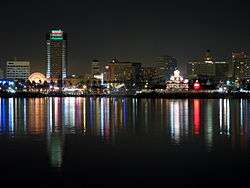
The following is a list of communities with populations over 50,000 in the Los Angeles metropolitan area with 2018 United States Census Bureau estimates of their population.[7] Communities in italics are unincorporated and their populations are from the 2010 Census, while those in bold are considered principal cities of the metropolitan area by the Census Bureau, which represent significant employment centers.[8]
|
|
|
Economy
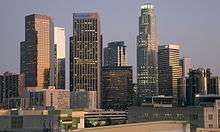
The economy of the Los Angeles metropolitan area is famously and heavily based on the entertainment industry, with a particular focus on television, motion pictures, interactive games, and recorded music – the Hollywood district of Los Angeles and its surrounding areas are known as the "movie capital of the United States" due to the region's extreme commercial and historical importance to the American motion picture industry. Other significant sectors include shipping/international trade – particularly at the adjacent Port of Los Angeles and Port of Long Beach, together comprising the United States' busiest seaport – as well as aerospace, technology, petroleum, fashion and apparel, and tourism.
The City of Los Angeles is home to five Fortune 500 companies: energy company Occidental Petroleum (until 2014 when it moved its headquarters to Houston), healthcare provider Health Net, metals distributor Reliance Steel & Aluminum, engineering firm AECOM, and real estate group CB Richard Ellis. Other companies headquartered in Los Angeles include American Apparel, City National Bank, 20th Century Fox, Latham & Watkins, Univision, Metro Interactive, LLC, Premier America, Gibson, Dunn & Crutcher, DeviantArt,[9] Guess?, O’Melveny & Myers; Paul, Hastings, Janofsky & Walker, Tokyopop, The Jim Henson Company, Paramount Pictures, Sunkist Growers, Incorporated, Tutor Perini, Fox Sports Net, Capital Group, and The Coffee Bean & Tea Leaf. Korean Air's US passenger and cargo operations headquarters are in two separate offices in Los Angeles.[10] Entertainment and media giant The Walt Disney Company is headquartered in nearby Burbank.
The Los Angeles-Orange County metro area alone has an economy of roughly $1.044 trillion (estimated for 2017[11]), or the total economic output or income of Indonesia's 250 million people; important are coastal California land values and the rents they command, which contribute heavily to GDP earnings, though there are worries that these high land values contribute to the long-term problem of housing affordability and are thus a possible risk to future GDP increase.[12][13] This is evident when comparing the coast with the Inland Empire, a large component of the five-county combined statistical area (CSA) that nevertheless contributes a far smaller portion to regional gross metropolitan product but still dominates in industry. The Southland CSA is the third-largest economic center in the world, after the Greater Tokyo Area and the New York-Newark-Bridgeport CSA.[14]
The Port of Los Angeles and Port of Long Beach together comprise the fifth-busiest port in the world, being the center of imports and exports for trade on the west Pacific Coast as well as being one of the most significant ports of the western hemisphere. The Port of Los Angeles occupies 7,500 acres (3,035 hectares) of land and water along 43 miles (69 kilometres) of waterfront and is the busiest container port in the United States. The Port is the busiest port in the United States by container volume, the 8th busiest container port in the world.[15][16][17] The top trading partners in 2004 were: China ($68.8 billion), Japan ($24.1 billion), Taiwan ($10.8 billion), Thailand ($6.7 billion), & South Korea ($5.6 billion)
The Port of Long Beach is the second-busiest container port in the United States. It adjoins the separate Port of Los Angeles. Acting as a major gateway for U.S.-Asian trade, the port occupies 3,200 acres (1,295 hectares) of land with 25 miles (40 kilometres) of waterfront in the city of Long Beach, California. The seaport has approximately $100 billion in trade and provides more than 316,000 jobs in Southern California. The Port of Long Beach imports and exports more than $100 billion worth of goods every year. The seaport provides the country with jobs, generates tax revenue, and supports retail and manufacturing businesses.
Long Beach–Los Angeles–Anaheim
The Long Beach–Los Angeles–Anaheim metropolitan statistical area is in the southern part of California. In 2014, the metro area's population reached 13,262,220 and ranked second in the United States – a 1 percent increase from 2013.[18] In 2014, Los Angeles-Long Beach-Anaheim had a per capita personal income (PCPI) of $50,751 and ranked 29th in the country.
In 2014, Los Angeles-Long Beach-Anaheim placed third among the largest exporters in the United States (shipment totaling to $75.5 billion). The metro accounted for 40.8 percent of California's merchandise exports, mainly exporting computer and electronic products ($18.6 billion); transportation equipment ($15.3 billion) and chemicals ($5.6 billion). Nonetheless, the greater Los Angeles metro has immensely benefited from the free trade agreements: greater Los Angeles exported $25.1 billion to the NAFTA region and $776 million in goods to the CAFTA region.
Overall, in 2014 the average wages and salaries reached $57,519 (in 2010, the average wages and salaries reached $54,729).[19] Meanwhile, the median household income in 2014 was $56,935, a 1.4 percent increase from 2013 (average median household income was $56,164).[20]
Note: Dollar items are in current dollars (not adjusted for inflation). Per capita items in dollars; other dollar items in thousands of dollars.
Table 2 (refer below) is a chart of the four highest sectors in the metro area, with health care and social assistance reaching 15.54%.
| Industry | Los Angeles-Long Beach-Anaheim, CA MSA |
| NAICS 62 Health care and social assistance | 15.54% |
| NAICS 44–45 Retail trade | 11.27% |
| NAICS 72 Accommodation and food services | 10.79% |
| NAICS 31–33 Manufacturing | 10.47% |
Table 3 (refer below) displays the location quotient for employment in the Los Angeles-Long Beach-Anaheim MSA. Top three sectors include information; art, entertainment, and recreation; and real estate and rental and leasing. (Data obtained from the Bureau of Labor Statistics, 2014. Data measures Location Quotient for sectors in the MSA area. U.S. Total is the base areas.[21])
| Industry | Los Angeles-Long Beach-Anaheim, CA MSA |
| NAICS 99 Unclassified | 2.46 |
| NAICS 51 Information | 1.88 |
| NAICS 71 Arts, entertainment, and recreation | 1.36 |
| NAICS 53 Real estate and rental and leasing | 1.29 |
| NAICS 42 Wholesale trade | 1.21 |
| NAICS 61 Educational services | 1.13 |
| NAICS 54 Professional and technical services | 1.11 |
| NAICS 56 Administrative and waste services | 1.06 |
| NAICS 81 Other services, except public administration | 1.04 |
| NAICS 31–33 Manufacturing | 1 |
| NAICS 62 Health care and social assistance | 1 |
| NAICS 72 Accommodation and food services | 1 |
| NAICS 55 Management of companies and enterprises | 0.95 |
| NAICS 48–49 Transportation and warehousing | 0.88 |
| NAICS 52 Finance and insurance | 0.86 |
| NAICS 44–45 Retail trade | 0.85 |
| NAICS 23 Construction | 0.76 |
| NAICS 22 Utilities | 0.65 |
| NAICS 11 Agriculture, forestry, fishing and hunting | 0.15 |
| NAICS 21 Mining, quarrying, and oil and gas extraction | 0.15 |
Utilities and infrastructure
There are nine electric utility power companies in the Los Angeles metropolitan area. Southern California Edison serves a large majority of the Los Angeles metropolitan area except for Los Angeles city limits, Burbank, Glendale, Pasadena, Azusa, Vernon, Anaheim, and southern Orange County. Southern Orange County is part of the Los Angeles metropolitan area and it is served by San Diego Gas & Electric. There are three natural gas providers in the metropolitan area. Southern California Gas Company serves a large majority of the Los Angeles metropolitan area except for Long Beach and southern Orange County.
The Los Angeles metropolitan area is served by the following utility companies.
Electricity
- Southern California Edison (largest electric utility in the Los Angeles metropolitan area)
- Los Angeles Department of Water and Power (second-largest electric utility in the Los Angeles metropolitan area and the largest within the Los Angeles city limits)
- Burbank Water and Power
- Glendale Water and Power
- Pasadena Water and Power
- Anaheim Water and Power
- Azusa Light & Power
- Vernon Light & Power
- San Diego Gas & Electric (serves southern Orange County, which is part of the Los Angeles metropolitan area)
The only nuclear power plant that serves the Los Angeles metropolitan area is Palo Verde Nuclear Generating Station in the US state of Arizona 46 miles west of Phoenix. LADWP and Southern California Edison get their electricity from it.
Natural gas
- Southern California Gas Company
- City of Long Beach Gas Company
- San Diego Gas & Electric (serves southern Orange County, which is part of the Los Angeles metropolitan area)
Cable television
- Charter Communications, known as Charter Spectrum (serves a majority of the Los Angeles metropolitan area)
- Cox Communications (serves parts of Orange County and the Palos Verdes peninsula)
Phone and Internet
- AT&T
- Frontier Communications
- Charter Spectrum (serves a large majority of the Los Angeles metropolitan area)
Demographics
| Historical population | |||
|---|---|---|---|
| Census | Pop. | %± | |
| 1890 | 115,043 | — | |
| 1900 | 189,994 | 65.2% | |
| 1910 | 538,567 | 183.5% | |
| 1920 | 997,830 | 85.3% | |
| 1930 | 2,327,166 | 133.2% | |
| 1940 | 2,916,403 | 25.3% | |
| 1950 | 4,367,911 | 49.8% | |
| 1960 | 6,742,696 | 54.4% | |
| 1970 | 8,462,366 | 25.5% | |
| 1980 | 9,410,130 | 11.2% | |
| 1990 | 11,273,720 | 19.8% | |
| 2000 | 12,365,627 | 9.7% | |
| 2010 | 12,828,837 | 3.7% | |
| Est. 2019 | 13,214,799 | 3.0% | |
| State Census data [22] | |||
According to the 2009 American Community Survey, the Los Angeles Metropolitan Area had a population of 12,874,797, of which 6,402,498 (49.7% of the population) were male and 6,472,299 (50.3% of the population) were female.
The age composition was the following:
- Under 5 years: 7.3%
- 5 to 9 years: 6.6%
- 10 to 14 years: 7.0%
- 15 to 19 years: 7.2%
- 20 to 24 years: 7.0%
- 25 to 34 years: 15.5%
- 35 to 44 years: 14.8%
- 45 to 54 years: 13.9%
- 55 to 59 years: 5.5%
- 60 to 64 years: 4.4%
- 65 to 74 years: 5.6%
- 75 to 84 years: 3.6%
- 85 years and over: 1.6%
Median age: 34.6 years
According to the survey, the Los Angeles Metropolitan Area was 54.6% White (32.2% non-Hispanic White alone), 7.0% Black or African American, 0.5% American Indian and Alaska Native, 13.9% Asian, 0.3% Native Hawaiian and Other Pacific Islander, 20.6% from Some other race, and 3.2% from Two or more races. Hispanics or Latinos of any race made up 44.8% of the population.
Whites are the racial majority; whites of both Hispanic and non-Hispanic origin make up 54.6% of the population. Non-Hispanic whites make up under one-third (32.2%) of the population. Approximately 7,028,533 residents are white, of which 4,150,426 are non-Hispanic whites.
The top five European ancestries are the following:
- German: 6.9% (883,124)
- Irish: 5.3% (786,541)
- English: 4.8% (619,364)
- Italian: 3.3% (425,056)
- French: 1.6% (204,635)
Blacks are a sizable minority; blacks of both Hispanic and non-Hispanic origin make up 7.0% of the population. Non-Hispanic blacks make up 6.7% of the population. Approximately 895,931 residents are black, of which 864,737 are non-Hispanic blacks. In the survey, 136,024 people identified their ancestry as "Sub-Saharan African", equal to 1.1% of the population.
American Indians are a small minority; American Indians of both Hispanic and non-Hispanic origin make up 0.5% of the population. American Indians of non-Hispanic origin make up 0.2% of the populace. Approximately 68,822 residents are American Indian, of which 26,134 are American Indians of non-Hispanic origin. Approximately 3,872 Cherokee, 1,679 Navajo, 1,000 Chippewa, and 965 Sioux reside in the area.
Asians are a large minority; Asians of both Hispanic and non-Hispanic origin make up 13.9% of the population. Asians of non-Hispanic origin make up 13.7% of the population. Approximately 1,790,140 residents are Asian, of which 1,770,225 are Asians of non-Hispanic origin.
The six Asian ancestries mentioned are the following:
- Filipino: 3.5% (454,086)
- Chinese: 3.0% (390,192)
- Korean: 2.1% (274,288)
- Vietnamese: 2.0% (254,353)
- Japanese: 1.0% (134,466)
- Indian: 0.9% (116,090)
"Other Asian" is an additional category that includes people who did not identify themselves as any of the groups above. This group includes people of Cambodian, Laotian, Pakistani, Burmese, Taiwanese, and Thai descent, among others. Approximately 166,665 people are in this category, and they make up 1.3% of the population.
Native Hawaiians and other Pacific Islanders are a very small minority; Native Hawaiians and other Pacific Islanders make up 0.3% of the population. Approximately 37,719 residents are Native Hawaiian or of other Pacific Islander ancestries, of which 33,982 are of non-Hispanic origin.
The three Pacific Islander ancestries mentioned are the following:
- Samoan: 0.1% (13,519)
- Native Hawaiian: 0.1% (6,855)
- Guamanian or Chamorro: <0.1% (4,581)
"Other Pacific Islander" is an additional category that includes people who did not identify themselves as any of the groups above. This group includes people of Fijian and Tongan descent, among others. Approximately 12,764 people are in this category, and they make up 0.1% of the population.
Multiracial individuals are a sizable minority; multiracial people of both Hispanic and non-Hispanic origin make up 3.2% of the population, of which 1.8% were of non-Hispanic origin. Approximately 405,568 people are multiracial, of which 228,238 are of non-Hispanic origin.
The four multiracial ancestries mentioned are the following:
- White and Asian: 0.8% (107,585)
- White and American Indian: 0.4% (55,960)
- White and Black or African American: 0.4% (53,476)
- Black or African American and American Indian: 0.1% (12,661)
Hispanic or Latinos, are, by far, the largest minority group; Hispanics or Latinos make up 44.8% of the population. They outnumber every other racial group. Approximately 5,763,181 residents are Hispanic or Latino.
The three Hispanic or Latino ancestries mentioned are the following:
- Mexican: 35.5% (4,570,776)
- Puerto Rican: 0.4% (48,780)
- Cuban: 0.4% (47,056)
"Other Hispanic or Latino" is an additional category that includes people who did not identify themselves as any of the groups above. This group include people of Costa Rican, Salvadoran, and Colombian descent, among others. Approximately 1,096,569 people are in this category, and they make up 8.5% of the population.
Source 1:[23]
Source 2:[24]
| County | 2017 Estimate | 2010 Census | Change | Area | Density |
|---|---|---|---|---|---|
| Los Angeles County | 10,163,507 | 9,818,605 | +3.51% | 4,057.88 sq mi (10,509.9 km2) | 2,498/sq mi (965/km2) |
| Orange County | 3,190,400 | 3,010,232 | +5.99% | 790.57 sq mi (2,047.6 km2) | 4,013/sq mi (1,549/km2) |
| Total | 13,353,907 | 12,828,837 | +4.09% | 4,848.45 sq mi (12,557.4 km2) | 2,745/sq mi (1,060/km2) |
Medical Services
Los Angeles and Orange counties have separate medical service department but both work jointly. Government and Private hospitals open normally Monday through Friday, excluding City Holidays but some speciality hospitals are open year round.
The main healthcare providers in the Los Angeles metropolitan area are Kaiser Permanente, Dignity Healthcare, and Providence Healthcare. LA Care and Care1st are also the main providers for those in the metropolitan area that have Medi-Cal.
Events
The Los Angeles metropolitan area boasts a large number of conventions and cultural events catering to the young people (teens and young adults) in the metropolitan area that are interested into many forms of popular culture entertainment including Japanese anime, video games, comics, sci-fi, Disney, and more. It also relates to the large and popular worldwide entertainment industry in the Los Angeles area.
The following are major Los Angeles metropolitan area events:
Anime Conventions
- Anime Expo at Los Angeles Convention Center
- Anime Los Angeles
- Anime Impulse at Fairplex in Pomona
- Anime California
- Anime Pasadena at Pasadena Convention Center
- Titan Con at California State University, Fullerton
Video Game Conventions
- E3 at Los Angeles Convention Center
- SoCal Retro Gaming Expo at Pasadena Convention Center
- BlizzCon at Anaheim Convention Center
Pop Culture and Comic Conventions
- Stan Lee's Los Angeles Comic Con, sometimes referred to as Los Angeles Comic Con or LACC, at Los Angeles Convention Center
- WonderCon at Anaheim Convention Center
Godzilla Convention
- Japan World Heroes at Pasadena Convention Center (the only Godzilla convention in the Los Angeles metropolitan area).[25]
Disney Convention
- D23 Expo at Anaheim Convention Center (held every two years)
Ethnic Cultural events
- Neisei Week in Little Tokyo, Los Angeles
Car Shows
- LA Auto Show at Los Angeles Convention Center
- OC Auto Show at Anaheim Convention Center
Annual County Fairs
- Los Angeles County Fair at Fairplex in Pomona
- Orange County Fair at Orange County Fairgrounds in Costa Mesa, California
Other Events in the Los Angeles metropolitan area
- Scare LA, a Halloween convention held at the Los Angeles Convention Center every August.
- VidCon, a YouTube video hosting convention held at the Anaheim Convention Center.
- CineGear Expo, a filmmaking convention held at Paramount Studios in Hollywood, Los Angeles
- KCON LA, a convention dedicating to Korean pop music, held at the Los Angeles Convention Center.
Tourism
Due to L.A.'s position as The Entertainment Capital of the World, there are many tourist attractions in the area. Consequently, the metropolitan L.A. is one of the most visited areas in the world. Here is a breakdown of some of its major attractions:
Amusement parks
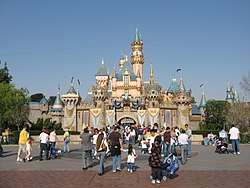
Beaches

- Capistrano Beach
- Corona del Mar
- Dana Point
- El Porto
- El Segundo
- Hermosa Beach
- Huntington Beach
- Laguna Beach
- Long Beach
- Los Angeles
- Malibu
- Manhattan Beach
- Marina del Rey
- Newport Beach
- Pacific Palisades
- Palos Verdes Estates
- Playa del Rey
- Rancho Palos Verdes
- Redondo Beach
- San Clemente
- San Pedro
- Santa Monica
- Seal Beach
- Venice Beach
Shopping malls

- Americana at Brand
- Anaheim GardenWalk
- Bella Terra
- Beverly Center
- Brea Mall
- Burbank Town Center
- Cerritos Auto Square
- Cerritos Towne Center
- Citadel Outlets
- Del Amo Fashion Center
- Downtown Disney
- Eastland Center
- Fashion Island
- Glendale Galleria
- Hollywood and Highland
- Irvine Spectrum Center
- Lakewood Center
- Laguna Hills Mall
- Los Cerritos Center
- Montclair Plaza
- Montebello Town Center
- Northridge Fashion Center
- Old Pasadena
- Ontario Mills
- Panorama Mall
- Paseo Colorado
- Plaza México
- Plaza West Covina
- Puente Hills Mall
- Rodeo Drive
- The Grove at Farmer's Market
- The Market Place
- The Outlets at Orange
- The Shops at Mission Viejo
- The Shops at Montebello
- The Village at Orange
- Third Street Promenade
- Sherman Oaks Galleria
- South Coast Plaza
- Stonewood Center
- Universal CityWalk
- Valencia Town Center
- Victoria Gardens
- Westfield Century City
- Westfield Fashion Square
- Westfield MainPlace
- Westfield Santa Anita
- Westfield Topanga
- Westfield West Covina
- Westminster Mall
- Westside Pavilion
Motion picture studios
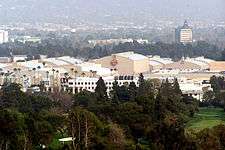
- 20th Century Fox
- Cartoon Network Studios
- CBS Television City
- CBS Studio Center
- CBS Columbia Square
- Charlie Chaplin Studios
- Downey Studios
- Fox Television Center
- Golden Oak Ranch
- Hollywood Center Studios
- Metromedia Square
- NBC Studios (Burbank)
- Nestor Studios
- Nickelodeon Animation Studios
- Nickelodeon on Sunset
- Old Warner Brothers Studio
- Paramount Studios
- Ren-Mar Studios
- Santa Clarita Studios
- Sony Pictures Entertainment
- Sunset Gower Studios
- The Prospect Studios
- Universal Studios
- Walt Disney Studios
- Warner Brothers Studios
Water parks
- Dry Town Water Park
- Raging Waters
- Knott's Soak City USA
- Six Flags Hurricane Harbor
- Wild Rivers (Defunct)
- Great Wolf Lodge
Zoos and aquariums
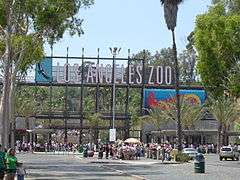
Night life
Museums
See also, Los Angeles City Museums
- A+D Museum
- A. S. Bradford House
- Academy Museum of Motion Pictures
- ARCO Center for Visual Art
- Adamson House
- Adobe Flores
- African American Firefighter Museum
- American Jewish University Art Galleries
- Antelope Valley Indian Museum
- Ard Eevin
- Autry Museum of the American West
- Avila Adobe
- Anaheim Carnegie Library
- Banning House
- Balboa Pavilion
- Barnsdall Art Park
- Bembridge House
- Ben Maltz Gallery
- Beverly Hills Women's Club
- Bixby-Bryant Ranch House
- Bolton Hall
- Bowers Museum
- California African American Museum
- California Science Center
- Campo de Cahuenga
- Catalina Casino
- Casa de Esperanza
- Casa de Parley Johnson
- Centinela Adobe
- Children's Museum of Los Angeles
- Chinese American Museum
- Claremont Station
- Community Clubhouse
- Craft and Folk Art Museum
- Crank House
- Diego Sepúlveda Adobe
- Discovery Cube Los Angeles
- Discovery Cube Orange County
- Dominguez Rancho Adobe
- Drum Barracks
- El Molino Viejo
- El Pueblo de Los Ángeles Historical Monument
- Fashion Institute of Design & Merchandising Museum
- Flight Path Learning Center & Museum
- Fort MacArthur
- Fowler Museum
- Franklin D. Murphy Sculpture Garden
- Frederick R. Weisman Art Foundation
- Fullerton Arboretum
- Geffen Contemporary at MOCA
- Getty Center
- Getty Villa
- George Key Ranch
- Grammy Museum
- Greystone Mansion
- Griffith Observatory
- Guinness World Record Museum
- Hammer Museum
- Heritage Square Museum
- Hollywood Erotic Museum
- Hollywood Heritage Museum
- Hollywood Museum
- Hollywood Wax Museum
- Howe-Waffle House and Carriage House
- Human Resources Los Angeles
- Huntington Library
- International Surfing Museum
- Italian American Museum of Los Angeles
- Japanese American National Museum
- John A. Rowland House
- John Woelke House
- Jonathan Bailey House
- Jose Serrano Adobe
- Judson Studios
- Kidspace Children's Museum
- Korean Cultural Center
- La Brea Tar Pits
- La Casa Alvarado
- La Casa Primera de Rancho San Jose
- LA Plaza de Cultura y Artes
- La Puente Valley Woman's Club
- Laguna Art Museum
- Lanterman House
- Leonis Adobe
- Lewis Ainsworth House
- Lighter-than-Air Ship Hangars
- Lomita Railroad Museum
- Lopez Adobe
- Los Angeles Contemporary Exhibitions
- Los Angeles County Museum of Art
- Los Angeles Fire Department Museum and Memorial
- Los Angeles Live Steamers Railroad Museum
- Los Angeles Maritime Museum
- Los Angeles Municipal Art Gallery
- Los Angeles Museum of the Holocaust
- Los Angeles Police Museum
- Los Cerritos Ranch House
- Los Encinos State Historic Park
- Los Rios Street Historic District
- Lummis House
- Lyon Air Museum
- Minnie Hill Palmer House
- Mission San Buenaventura
- Mission San Fernando Rey de España
- Mission San Gabriel Arcángel
- Mission San Juan Capistrano
- Modjeska House
- Montanez Adobe
- Movieland Wax Museum
- Muckenthaler House
- Museum of Death
- Museum of Contemporary Art
- Museum of Jurassic Technology
- Museum of Latin American Art
- Museum of Tolerance
- Natural History Museum of Los Angeles County
- Nethercutt Collection
- Newland House
- Newport Sports Museum
- Norton Simon Museum
- Ocean Institute
- Orange County Museum of Art
- Old Orange County Courthouse
- Old Plaza Firehouse
- Pacific Asia Museum
- Page Museum (La Brea Tar Pits)
- Pasadena Museum of California Art
- Pasadena Museum of History
- Petersen Automotive Museum
- Phillip Ackley Stanton House
- Phillips Mansion
- Point Fermin Light
- Point Vicente Light
- Pomona City Stables
- Pretend City Children's Museum
- Psychiatry: An Industry of Death
- Queen Anne Cottage and Coach Barn
- Queen Mary
- Ralph J. Bunche House
- Rancho Los Alamitos
- REDCAT
- Richard Egan House
- Richard Nixon Birthplace
- Richard Nixon Presidential Library and Museum
- Ripley's Believe It or Not!
- Rómulo Pico Adobe
- Ronald Reagan Presidential Library
- San Dimas Hotel
- Schindler House
- Scripps Hall
- Simi Adobe-Strathearn House
- Skatelab
- Skirball Cultural Center
- Social and Public Art Resource Center
- Southwest Museum of the American Indian
- SS Lane Victory
- The Broad
- Toyota USA Automobile Museum
- Travel Town Museum
- USC Fisher Museum of Art
- USS Iowa Museum
- Velveteria
- Virginia Robinson Gardens
- Watts Towers
- Wayfarers Chapel
- Workman and Temple Family Homestead Museum
- Ygnacio Palomares Adobe
Presidential museums
- Richard Nixon Presidential Library and Museum
- Ronald Reagan Presidential Library
Convention Centers
State parks & beaches
- Antelope Valley California Poppy State Reserve
- Antelope Valley Indian Museum State Historic Park
- Arthur B. Ripley Desert Woodland State Park
- Bolsa Chica State Beach
- Castaic Lake State Recreation Area
- Corona del Mar State Beach
- Crystal Cove State Park
- Dockweiler State Beach
- Doheny State Beach
- Emma Wood State Beach
- Huntington State Beach
- Kenneth Hahn State Recreation Area
- Leo Carrillo State Park
- Los Angeles State Historic Park
- Los Encinos State Historic Park
- Malibu Creek State Park
- Malibu Lagoon State Beach
- Mandalay State Beach
- McGrath State Beach
- Pescadero State Beach
- Pío Pico State Historic Park
- Placerita Canyon State Park
- Point Dume State Beach
- Point Mugu State Park
- Rio de Los Angeles State Park
- Robert H. Meyer Memorial State Beach
- Saddleback Butte State Park
- San Buenaventura State Beach
- San Clemente State Beach
- San Onofre State Beach
- Santa Monica State Beach
- Santa Susana Pass State Historic Park
- Topanga State Park
- Verdugo Mountains State Recreation Area
- Watts Towers of Simon Rodia State Historic Park
- Will Rogers State Historic Park
- Will Rogers State Beach
National parks, monuments, & refuges
Other
- Anaheim Grove
- Alamitos Bay
- Balboa Fun Zone
- Balboa Inn
- Balboa Island
- Balboa Pier
- Balboa Peninsula
- Bear Mountain Ski Resort
- Belmont Veterans Memorial Pier
- Big Bear Lake
- Bolsa Chica Ecological Reserve
- Catalina Island
- Cathedral of Our Lady of the Angels
- Commerce Casino
- Crystal Cathedral
- Devil's Punchbowl
- Dolby Theatre
- Downtown Los Angeles
- Echo Park
- El Capitan Theatre
- El Dorado Park
- Elizabeth Lake
- Exposition Park
- Fashion Island
- Grauman's Chinese Theatre
- Griffith Park
- Hollywood and Highland Center
- Hollywood Boulevard
- Hollywood Bowl
- Hollywood Forever Cemetery
- Hollywood Sign
- Hollywood Walk of Fame
- Hsi Lai Temple
- Huntington Beach Pier
- Irvine Regional Park
- Jet Propulsion Laboratory
- Korean Bell of Friendship
- La Brea Tar Pits
- Lake Elsinore
- Lake Mission Viejo
- Lake Palmdale
- Levitated Mass
- Long Beach Marine Stadium
- Los Angeles International Airport
- Magic Castle
- Mount Wilson Observatory
- Mountain High
- Naples Island
- Newport Back Bay
- Newport Bay
- Newport Center
- Newport Pier
- OC Fair & Event Center
- O'Neill Regional Park
- Orange County Great Park
- Palm Springs Aerial Tramway
- Pyramid Lake
- Randy's Donuts
- Redondo Beach pier
- Santa Monica Pier
- Sleeping Beauty Castle
- Snow Summit
- Space Flight Operations Facility
- Space Shuttle Endeavour
- Strand Beach Funicular
- Mission Inn
- The Plaza
- Top of the World
- Urban Light
- Universal City
- Venice
- Vincent Thomas Bridge
- Walt Disney Concert Hall
Transportation
Commercial airports
| Airport | IATA code | County | Enplanements (2013)[26] |
|---|---|---|---|
| Los Angeles International Airport | LAX | Los Angeles | 32,425,892 |
| John Wayne Airport | SNA | Orange | 4,540,628 |
| Ontario International Airport | ONT | San Bernardino | 1,970,538 |
| Bob Hope Airport | BUR | Los Angeles | 1,918,011 |
| Long Beach Airport | LGB | Los Angeles | 1,438,756 |
The primary airport serving the LA metro area is Los Angeles International Airport (LAX), one of the busiest airports in the United States. LAX is in southwestern Los Angeles, 16 miles (26 km) from Downtown Los Angeles. LAX is the only airport to serve as a hub for all three U.S. legacy airlines —American, Delta and United.
In addition to LAX, other airports, including Bob Hope Airport, John Wayne Airport, Long Beach Airport, and LA/Ontario International Airport, also serve the region.
Bridges
The Los Angeles metropolitan area has only one suspension bridge: Vincent Thomas Bridge in San Pedro, and one cable-stayed bridge: Gerald Desmond Bridge in Long Beach.
Interstates
.svg.png)
.svg.png)
.svg.png)
.svg.png)
.svg.png)
.svg.png)
.svg.png)
.svg.png)
.svg.png)
U.S. highways
.svg.png)
.svg.png)
.svg.png)
California state highways




































Los Angeles County Metro
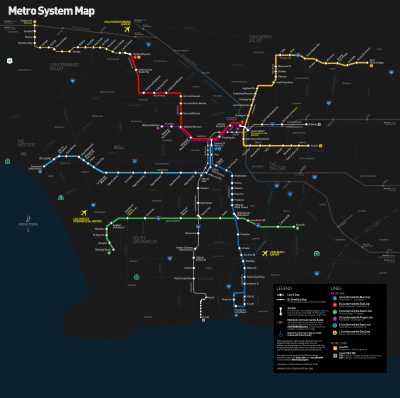
The Metro Rail is the mass transit rail system of Los Angeles County. It is run by the Los Angeles County Metropolitan Transportation Authority and its system runs six rail lines throughout Los Angeles County. Metro Rail currently operates four light rail lines and two rapid transit subway lines, altogether totaling 87.7 miles (141.1 km) of rail, 101 stations, and over 360,000 daily weekday boardings as of December 2012.[28]
- The A Line (Blue) – Light Rail
- The B Line (Red) – Heavy Rail
- The C Line (Green) – Light Rail
- The D Line (Purple) – Heavy Rail
- The E Line (Expo) – Light Rail
- The G Line (Orange) – Busway
- The J Line (Silver) – Busway
- The L Line (Gold) – Light Rail
The systems light rail system is the second busiest LRT system in the United States, after Boston, by number of riders, with 200,300 average weekday boardings during the third quarter of 2012.[29] By 2019, it had become the most heavily-ridden light rail system in the country.[30]
Since the region of the city is in close proximity to a major fault area the tunnels were built to resist earthquakes of up to magnitude 7.5. Both subway lines use an electrified third rail to provide power to the trains, rendering these lines unusable on the other three. The Blue and Gold Lines run mostly at grade, with some street-running, elevated, and underground stretches in the more densely populated areas of Los Angeles. The Green Line is entirely grade separated, running in the median of I-105 and then turning southward along an elevated route.
The rail lines run regularly on a 5 am and midnight schedule, seven days a week. Limited service on particular segments is provided after midnight and before 5 am There is no rail service between 2 and 3:30 am Exact times vary from route to route; see individual route articles for more information.
Orange County Transportation Authority (OCTA)
Regional and commuter rail
There are two providers of heavy rail transportation in the region, Amtrak and Metrolink. Amtrak provides service to San Diego, Santa Barbara, San Luis Obispo, and points in between on the Pacific Surfliner. It also provides long-distance routes, including the Coast Starlight which goes to the San Francisco Bay Area, Portland, Oregon, and Seattle, Washington; the Southwest Chief which goes to Flagstaff, Arizona, Albuquerque, New Mexico, Kansas City, Missouri and Chicago; and the Sunset Limited which provides limited service (three days a week) to Tucson, El Paso, Houston, and New Orleans.
Metrolink provides service to numerous places within Southern California, including all counties in the region. Metrolink operates to 55 stations on seven lines within Southern California which mostly (except for the Inland Empire-Orange County Line) radiate from Los Angeles Union Station.
Codes of metropolitan Los Angeles
Area codes
- 213 – Downtown Los Angeles, surrounded by 323 (October 1947)
- 310/424 – Santa Monica, Malibu, Pacific Palisades, Compton, Lynwood, Torrance, Beverly Hills, Catalina Island; the southwestern portion of Los Angeles County. (Split from 213 on November 2, 1991; overlaid by 424 on August 26, 2006)
- 323 – a ring around downtown Los Angeles, including the Hollywood and Eagle Rock neighborhoods of Los Angeles; South Los Angeles; the cities of South Gate, Huntington Park, Vernon, Walnut Park, Florence, Bell, Bell Gardens, Cudahy, Montebello, and East Los Angeles. (Split from 213 on June 13, 1998)
- 562 – Long Beach, Downey, Whittier; Norwalk, Lakewood, Bellflower, Paramount, Cerritos, southeast Los Angeles County, and a small portion of coastal Orange County. (Split from 310 on January 25, 1997)
- 626 – Pasadena, Monterey Park, Rowland Heights, Alhambra, and West Covina; the San Gabriel Valley, and eastern suburbs of Los Angeles. (Split from 818 on June 14, 1997)
- 657/714 – Anaheim, Huntington Beach, Santa Ana, Orange, Garden Grove; northern and western Orange County (Overlaid by 657 on September 23, 2008)
- 661 – Bakersfield, Santa Clarita, Palmdale; northern Los Angeles County including the Antelope Valley, and most of Kern County, including the southern San Joaquin Valley. (Split from 805 on February 13, 1999)
- 747/818 – the cities of Burbank, Glendale, San Fernando; the North Hollywood, Van Nuys, Panorama City, Sherman Oaks, and Northridge neighborhoods of Los Angeles; the San Fernando Valley. (Split from 213 on January 7, 1984)
- 909 – Pomona, Walnut, Diamond Bar, San Dimas, La Verne, Claremont, and Eastern Glendora. (The Eastern San Gabriel Valley)
- 949 – Irvine, Laguna Beach, Newport Beach, San Juan Capistrano; southern and eastern Orange County. (Split from 714 on April 18, 1998)
ZIP codes
The following is the list of ZIP codes for select areas within the metropolitan area.
- 92704 in Santa Ana • 91,106
- 92804 in Anaheim • 81,362
- 90631 in La Habra • 67,164
- 92677 in Laguna Niguel • 62,329
- 92627 in Costa Mesa • 62,275
- 92630 in Lake Forest • 59,157
- 92647 in Huntington Beach • 58,874
- 92780 in Tustin • 55,092
- 92708 in Fountain Valley • 54,588
- 92840 in Garden Grove • 50,702
- 92870 in Placentia • 48,670
- 92653 in Laguna Hills • 48,024
- 90630 in Cypress • 47,617
- 92691 in Mission Viejo • 46,463
- 92833 in Fullerton • 46,263
- 90620 in Buena Park • 44,535
- 92705 in North Tustin • 43,913
- 92843 in Garden Grove • 43,788
- 92688 in Rancho Santa Margarita • 42,491
- 92656 in Aliso Viejo • 41,551
- 92612 in Irvine • 41,101
- 92867 in Orange • 40,648
- 92807 in (Anaheim • 6,076) and (Anaheim Hills • 34,384) • 40,460
- 92886 in Yorba Linda • 39,242
- 92672 in San Clemente • 34,869
- 92675 in San Juan Capistrano • 34,409
- 92821 in Brea • 34,122
- 90621 in Buena Park • 33,556
- 92679 in Coto de Caza • 32,205
- 92841 in Garden Grove • 31,586
- 90680 in Stanton • 29,522
- 92660 in Newport Beach • 28,755
- 92604 in Irvine • 27,452
- 92629 in Dana Point • 27,441
- 92651 in Laguna Beach • 24,968
- 90740 in Seal Beach • 24,308
- 92844 in Garden Grove • 23,510
- 90720 in Los Alamitos • 21,004
- 92808 in Anaheim Hills • 19,613
- 92610 in Foothill Ranch • 10,940
- 92861 in Villa Park • 6,002
- 92657 in Newport Coast • 5,752
- 92694 in Las Flores • 433
- 90201 in Bell Gardens • 105,277
- 90650 in Norwalk • 103,183
- 90011 in Los Angeles • 101,770
- 90280 in South Gate • 96,296
- 90250 in Hawthorne • 93,628
- 90805 in Long Beach • 91,456
- 91744 in La Puente • 84,973
- 90255 in Huntington Park • 77,926
- 91706 in Irwindale • 76,941
- 90706 in Bellflower • 72,829
- 90262 in Lynwood • 69,918
- 91766 in Pomona • 69,757
- 90022 in East Los Angeles • 68,596
- 93550 in Palmdale • 67,384
- 90660 in Pico Rivera • 63,028
- 91732 in El Monte • 62,754
- 90640 in Montebello • 62,304
- 91770 in Rosemead • 61,780
- 91351 in Santa Clarita • 59,530
- 93535 in Lancaster • 57,928
- 91702 in Azusa • 57,505
- 91343 in North Hills • 56,946
- 90745 in Carson • 55,426
- 90723 in Paramount • 55,317
- 90001 in Florence-Graham • 54,587
- 91801 in Alhambra • 54,432
- 91745 in Hacienda Heights • 53,623
- 90703 in Cerritos • 51,510
- 90221 in Compton • 51,396
- 90638 in La Mirada • 47,507
- 90247 in Gardena • 47,317
- 91765 in Diamond Bar • 46,647
- 91748 in Rowland Heights • 46,140
- 91733 in South El Monte • 45,795
- 91789 in Walnut • 44,901
- 91790 in West Covina • 43,788
- 90242 in Downey • 42,730
- 90503 in Torrance • 42,042
- 91205 in Glendale • 41,431
- 90275 in Rancho Palos Verdes • 41,431
- 91016 in Monrovia • 41,029
- 90605 in Whittier • 38,349
- 91776 in San Gabriel • 37,969
- 90604 in South Whittier • 37,873
- 90278 in Redondo Beach • 37,297
- 91001 in Altadena • 36,310
- 91750 in La Verne • 35,011
- 91773 in San Dimas • 34,674
- 91711 in Claremont • 34,374
- 90266 in El Segundo • 33,924
- 91340 in San Fernando • 33,878
- 90260 in Lawndale • 33,366
- 91754 in Monterey Park • 33,120
- 91780 in Temple City • 32,441
- 90606 in West Whittier/Los Nietos • 32,426
- 91792 in West Covina • 31,391
- 91746 in Industry • 31,102
- 91007 in Arcadia • 30,901
- 91006 in Arcadia • 30,165
- 91731 in El Monte • 29,964
- 90304 in Lennox • 28,385
- 90270 in Maywood • 28,083
- 90303 in Inglewood • 27,781
- 90713 in Lakewood • 27,656
- 91010 in Duarte • 27,364
- 91755 in Monterey Park • 26,993
- 90249 in Gardena • 26,015
- 91740 in Glendora • 25,200
- 91301 in Agoura Hills • 25,104
- 90274 in Palos Verdes Eststes • 24,892
- 90061 in Willowbrook • 24,788
- 91030 in South Pasadena • 23,893
- 91302 in Calabasas • 23,645
- 91775 in East San Gabriel • 23,384
- 91384 in Val Verde • 22,098
- 90717 in Lomita • 21,057
- 90715 in Lakewood • 21,023
- 91011 in La Cañada Flintridge • 20,317
- 90265 in Malibu • 19,816
- 90254 in Hermosa Beach • 18,557
- 91506 in Burbank • 18,310
- 91354 in Santa Clarita • 17,832
- 90502 in West Carson • 17,119
- 90701 in Artesia • 16,380
- 90716 in Hawaiian Gardens • 14,872
- 91108 in San Marino • 13,347
- 90210 in Beverly Hills • 11,310
- 91024 in Sierra Madre • 10,536
- 90040 in Commerce • 9,737
- 90755 in Signal Hill • 9,273
- 93510 in Acton • 8,077
- 90056 in Ladera Heights • 8,038
- 91020 in La Crescenta-Montrose • 7,343
- 90704 in Avalon • 3,696
- 90058 in Vernon • 3,495
Sports
Sports teams
As a whole, the Los Angeles area has more national championships, all sports combined (college and professional), than any other city in the United States, with over four times as many championships as the entire state of Texas, and just over twice that of New York City.[31] It is the only American city to host the Olympic games twice: once in 1932, and more recently in 1984. Los Angeles will also be the host of the 2028 Summer Olympics, becoming the third city to host three Olympic Games, after London and Paris.
Listing of the professional sports teams in the Los Angeles metropolitan area
- National Football League (NFL)
- National Basketball Association (NBA)
- Women's National Basketball Association (WNBA)
- Major League Baseball (MLB)
- National Hockey League (NHL)
- Major League Soccer (MLS)
- Los Angeles Galaxy
- Los Angeles Football Club
Professional venues
Note # symbol means venue has held an Olympic event.
- Angel Stadium
- Auto Club Raceway
- Auto Club Speedway
- Dignity Health Sports Park #
- Dodger Stadium #
- Hollywood Park Racetrack (Defunct) Now the site of SoFi Stadium, an NFL stadium under construction
- Honda Center
- John C. Argue Swim Stadium #
- Long Beach Marine Stadium#
- Los Angeles Memorial Coliseum# (Temporary)
- Los Angeles Memorial Sports Arena (Defunct) Now, Banc of California Stadium#
- Rose Bowl #
- Santa Anita Park #
- Staples Center
- The Forum #
- VELO Sports Center
Media
The Los Angeles metropolitan area is home to the headquarters of several well-known media companies including: the Los Angeles Times, Fox Broadcasting Company, Universal Studios, and The Walt Disney Company. Local television channels broadcasting to the Los Angeles market include KCBS-TV 2 (CBS), KNBC 4 (NBC), KTLA 5 (CW), KABC 7 (ABC), KCAL-TV 9 (Independent/CBS), KTTV 11 (FOX), KCOP 13 (myNetworkTV), KPXN-TV 38/30 (Ion), and KLCS 41/58 (PBS). Radio stations serving the area include: KKJZ, KIIS, KNX (AM), and KSUR.
Education
Primary and Secondary Education
The Los Angeles Unified School District serves the city of L.A., and other school districts serve the surrounding areas. A number of private schools are also located in the region.
Higher Education
The Los Angeles metropolitan area is home to a number of colleges and universities. The University of Southern California and University of California, Los Angeles are among the largest, and the Claremont Colleges and California Institute of Technology are among the most academically renowned. Below is a list of colleges and universities within the Los Angeles Metropolitan Area.
- Azusa Pacific University
- California State University, Channel Islands
- California State University, Dominguez Hills
- California State University, Fullerton
- California State University, Northridge
- California State University, Long Beach
- California State University, Los Angeles
- California State University, San Bernardino
- California Institute of Technology
- Chapman University
- Claremont Colleges
- Laguna College of Art and Design
- University of California, Irvine
- University of California, Los Angeles
- University of California, Riverside
- University of California, Santa Barbara
- University of Southern California
- Pepperdine University
- Soka University of America
- Vanguard University
Geology

Much of the west coast of North America was part of a large convergent plate boundary between the Farallon Plate and North American Plate from 165 to 55 million years ago. Here, the Farallon Plate subducted under the North American Plate creating volcanoes about 100 miles east of this boundary which can still be seen as the Sierra Nevada which it has its southern border about 30 miles east of Grapevine, California in the Tejon Pass. The Farallon Plate was subjected to high temperatures and pressures as it subducted under the North American Plate. This led to the formation of molten plutons which rose because they were less dense than the surrounding magma. When they rose, they cooled and some formed enormous granite monoliths. Only less than 1% of these plutons ever made it to the surface out of a volcano or fissure vent. The 1% that did make it all the way to the surface erupted in andesitic lava which would pile on top of each previous flow. This would create steep volcanoes with extremely high elevations. Most of the ejecta that came out of a volcano is gas. About 60% is just carbon (C) and water vapor (H2O). About 30% is sulfur (S). The sulfur mixes with the water vapor to form sulfuric acid which is notorious for eating away at almost anything from plants to rocks.
For the 99% percent of plutons that didn't make it to the surface they cooled to form granite monoliths under these volcanoes. When subduction activities ceased about 55 million years ago, these volcanoes were subject to erosion due to their steep slopes. Because granite is classified as a hard igneous rock, it is the only remnant of the volcanic chain from this subduction zone. These enormous granite monoliths can still be seen in Yosemite National Park as Half Dome and El Capitan about 300 miles from Los Angeles. Please refer to the Geologic History of Yosemite page to learn more specifically of the area's local geology.
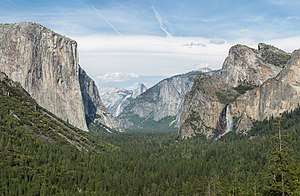
When the subduction zone ceased about 55 million years ago, the Farallon Plate was split into two distinctive plates which can still be observed today as the Juan de Fuca Plate and the Cocos Plate. Both were part of the same plate, but were discovered independently before this connection was made. At the time of this break off, the Pacific Plate had a general north west movement while the North American Plate had a general south east movement. This created a new fault zone when a weak point gave way between these two plates. This is the beginnings of the infamous San Andreas Fault. The San Andreas Fault is a right-lateral strike strip transverse fault. When this fault was just created, a volcano from the ancient subduction zone was situated about 3/4th on the Pacific Plate and 1/4th on the North American plate somewhere in what is today Central California. Nearly 55 million years later, this volcano was offset by about 250 miles. It is the largest known offset of the San Andreas Fault and it help geologist determine important information such as average slip movement and the age of the fault. The northern part of this offset is now called Pinnacles National Park near Soledad, California. The other half of Pinnacles is in Three Points, California in Los Angeles County.
The Pacific Plate is the largest known plate on Earth. It is considered an oceanic plate because it is much more dense than a continental plate. That is the reason why oceanic plates always subduct under another plate. There are only a few places where the Pacific Plate is actually above the ocean. Most of the coastline of the state, below Eureka, California is part of the Pacific plate. The thickest part on land in California can be observed as far inland as the Salton Sea. To the south of the Salon Sea, there is a gap between plate boundaries. This gap acts like a divergent plate boundary where the land is being pulled apart. Mud volcanoes can be observed just at the southern edge of the sea as well as hot springs. Geothermal energy plants are abundant in the area, which power much of the local rural communities.
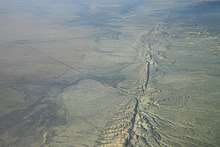
When the San Andreas Fault originally formed, tension on the North American Plate grew. The plate buckled and began uplifting similar to swelling in nearly all portions of the west. Numerous faults were created as a result; geologic blocks that rose and fell over and over again in patterns and in sequences. The extension of surface led to cracks which formed many independent faults. This is the creation of the Basin and Range Province. Sometimes these faults created a pathway, which molten rock could flow up to the surface creating cinder cone volcanoes. The Los Angeles Area has a few volcanoes that formed. Along Route 66 in Amboy, California, is the extinct volcano Amboy Crater which is estimated to be aged at 80,000 years. It is relatively new in geologic terms, but heavily eroded by wind. While driving along Interstate 40, lava fields can stretch for miles. Within Death Valley National Park is another, much larger cinder cone volcano called Ubehebe Crater. It is extremely young, although many geologists dispute the numbers with some estimates as old as 10,000 years with recent ages such as 800 years. One thing is for sure: this volcano is still very active and can erupt. Because of its location, it will likely not affect many people. Within Orange County, lava flows and dikes can be seen in El Modena although no actual crater can be seen, likely because either it has been totally eroded or it was formed in a small fissure, which would explain why it's so localized.
The land on which the Los Angeles metropolitan area sits is among the newest rocks in the continental United States. It is estimated to be about 20 million years old. Most of the rocks in this area are part of the larger Monterey Formation which covers most of the California coastal ranges. The Monterey Formation consists of shale rocks, which were created from the accumulation calcium-rich shells of dead marine life of millions of years. Before then, it was submerged and was part a shallow ocean floor. It has since been uplifted due to pressures between the many different fault zones at an average rate of 2 millimeters per year.
The Los Angeles area is known to be geologically active. The San Andreas Fault is about 40 miles north east of Downtown Los Angeles. The closest towns and cities to Los Angeles which contain the San Andreas Fault are Gorman and Palmdale, California. Historically, major earthquakes have occurred along the fault, large enough to cause fatalities and millions of dollars in damages. A major earthquake hasn't happened in the southern section of the San Andreas Fault in over 150 years and geologist have determined a 50% probability of a 7.0 earthquake, registered on the moment magnitude scale within the years 2010 to 2040. Some geologists say this probably is over speculated. There is no way to accurately predict an earthquake anywhere on any specific fault. On the contrary, major efforts have been made to fund a practical earthquake warning system, similar to what Japan used in Tokyo during the 2011 Japan earthquake, in Southern California. Today, the area gets hits with many earthquakes per day, most reregistering below a 2.5 on the moment magnitude scale, too insignificant to feel any shaking on the surface.
List of major fault zones
Note: Plate boundary faults are indicated with a (#) symbol.
- Brawley Seismic Zone
- Chino Fault
- Elsinore Fault Zone
- Elysian Park Fault
- Garlock Fault
- Hosgri Fault
- Imperial Fault Zone
- Laguna Salada Fault
- Newport–Inglewood Fault
- Peninsular Ranges
- Puente Hills Fault
- Raymond Fault
- Rose Canyon Fault
- Salton Trough
- Salinian Block
- San Andreas Fault #
- San Cayetano Fault
- San Felipe Fault Zone
- San Gabriel Fault
- San Jacinto Fault Zone
- Santa Maria River Fault
- Santa Ynez Fault
- Shoreline Fault
- Ventura Fault
- White Wolf Fault
- Whittier Fault
- Yorba Linda Fault
Significant earthquakes
Note: Earthquakes with epicenters in the Los Angeles Metro Area are marked with the (#) symbol. Other earthquakes mentioned means shaking was felt.
- 1812 San Juan Capistrano earthquake
- 1857 Fort Tejon earthquake
- 1892 Laguna Salada earthquake
- 1899 San Jacinto earthquake
- 1918 San Jacinto earthquake
- 1933 Long Beach earthquake #
- 1940 El Centro earthquake
- 1948 Desert Hot Springs earthquake
- 1971 San Fernando earthquake #
- 1979 Imperial Valley earthquake
- 1968 Borrego Mountain earthquake
- 1986 North Palm Springs earthquake
- 1987 Superstition Hills and Elmore Ranch earthquakes
- 1987 Whittier Narrows earthquake #
- 1991 Sierra Madre earthquake #
- 1992 Big Bear earthquake #
- 1992 Landers earthquake
- 1994 Northridge earthquake #
- 2008 Chino Hills earthquake #
- 2010 Baja California earthquake
- 2019 Ridgecrest earthquake
See also
- Chicago metropolitan area
- Greater Los Angeles Area
- List of Metropolitan Statistical Areas
- New York metropolitan area
References
- List of Southland's worst schools released | abc7.com Archived April 13, 2010, at the Wayback Machine. Abclocal.go.com (March 8, 2010). Retrieved on July 29, 2013.
- Largest Metropolitan Areas in the U.S. – Most Populous Metros. Geography.about.com. Retrieved on July 29, 2013.
- "Current Lists of Metropolitan and Micropolitan Statistical Areas and Definitions". United States Census Bureau. Retrieved December 25, 2009.
- "Table 1. Annual Estimates of the Population of Metropolitan and Micropolitan Statistical Areas: April 1, 2010 to July 1, 2016" (CSV). 2016 Population Estimates. United States Census Bureau, Population Division. March 2016. Retrieved March 23, 2017.
- "Combined Statistical Area Population Estimates File for Internet Display". US Census Bureau. 2017. Retrieved March 23, 2018.
- U.S. Census website . Census.gov. Retrieved on March 22, 2018.
- Bureau, U. S. Census. "U.S. Census website". United States Census Bureau. Retrieved September 25, 2019.
- "About Metropolitan and Micropolitan Statistical Areas". United States Census Bureau. February 28, 2013. Retrieved March 27, 2013.
- "DeviantArt, Inc." Businessweek Investing. Accessed November 9, 2008.
- "Contact Info". Korean Air. Retrieved September 20, 2008.
- Analysis, US Department of Commerce, BEA, Bureau of Economic. "Bureau of Economic Analysis". BEA.gov. Retrieved April 27, 2017.
- "Terner Center". ternercenter.berkeley.edu. Retrieved June 22, 2019.
- "California's High Housing Costs: Causes and Consequences". lao.ca.gov. Retrieved June 22, 2019.
- The 150 richest cities in the world by GDP in 2005, dated March 11, 2007. The list fails to include Taipei. Accessed July 3, 2007.
- "World Port Rankings – 2005" Archived September 27, 2007, at the Wayback Machine – Port Industry Statistics – American Association of Port Authorities (AAPA) – Updated May 1, 2007 – (Microsoft Excel *.XLS document)
- "North American Port Container Traffic – 2006" Archived December 19, 2008, at the Wayback Machine – Port Industry Statistics – American Association of Port Authorities (AAPA) – Updated May 14, 2007 – (Adobe Acrobat *.PDF document)
- FAQ # 22 Archived June 13, 2010, at the Wayback Machine at the Port of Los Angeles.org
- "Los Angeles-Long Beach-Anaheim, CA MSA Situation & Outlook Report". proximityone.com. Retrieved September 25, 2019.
- "Los Angeles-Long Beach-Anaheim, CA MSA Situation & Outlook Report". proximityone.com. Retrieved September 25, 2019.
- http://www.meyersresearchllc.com/wp-content/uploads/2014/08/Zonda_Market_Report_CA_Los-Angeles-Long-Beach-Anaheim.pdf
- "QCEW Establishment Size Classes (For NAICS-Based Data)". www.bls.gov. Retrieved September 25, 2019.
- "Archived copy". Archived from the original on June 28, 2014. Retrieved June 16, 2014.CS1 maint: archived copy as title (link)
- American FactFinder Archived December 13, 2012, at Archive.today. Factfinder.census.gov. Retrieved on July 29, 2013.
- American FactFinder Archived July 19, 2011, at Archive.today. Factfinder.census.gov. Retrieved on July 29, 2013.
- https://japanworldheroes.com/
- "Commercial Service Airports based on Calendar Year 2013 Enplanements" (PDF). FAA. January 26, 2015. Retrieved April 15, 2018.
- Los Angeles County Road Atlas (Map). Thomas Brothers. 2008.
- "Facts at a Glance". LACMTA. January 15, 2013. Retrieved January 20, 2013.
- Los Angeles County Metropolitan Transit Authority, Facts at a Glance, January 15, 2013.
- "Transit Ridership Report Fourth Quarter 2018" (PDF). American Public Transportation Association. February 27, 2020. Retrieved April 4, 2020 – via https://www.apta.com/research-technical-resources/transit-statistics/ridership-report/ridership-report-archives/.
- "Los Angeles Sports Travel". Los Angeles Sports Travel. Archived from the original on January 18, 2010. Retrieved February 1, 2010.

